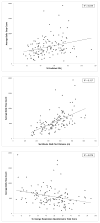Daily step counts in a US cohort with COPD
- PMID: 22521225
- PMCID: PMC3575136
- DOI: 10.1016/j.rmed.2012.03.016
Daily step counts in a US cohort with COPD
Abstract
Background: Baseline values for daily step counts in US adults with COPD and knowledge of its accurate measurement, natural change over time, and independent relationships with measures of COPD severity are limited.
Methods: 127 persons with stable COPD wore the StepWatch Activity Monitor (SAM) for 14 days, and 102 of them wore it a median 3.9 months later. SAM counts were compared to manual counts in the clinic. We assessed change over time, the effect of season, and relationships with forced expiratory volume in 1 s (FEV(1)) % predicted, 6-min walk test (6MWT) distance, the modified Medical Research Council (MMRC) dyspnea score, and the St. George's Respiratory Questionnaire Total Score (SGRQ-TS).
Results: 98% of subjects were males, with mean age 71 ± 8 years and FEV(1) 1.48 ± 0.54 L (52 ± 19% predicted). All 4 GOLD stages were represented, with the most subjects in GOLD II (44%) and GOLD III (37%). The SAM had >90% accuracy in 99% of subjects. Average step count was 5680 steps/day, which decreased with increasing GOLD stage (p = 0.0046). Subjects walked 645 fewer steps/day at follow-up, which was partly explained by season of monitoring (p = 0.013). In a multivariate model, FEV(1) % predicted, 6MWT distance and MMRC score were weakly associated with daily step counts, while SGRQ-TS was not.
Conclusions: These findings will aid the design of future studies using daily step counts in COPD. Accurately measured, daily step counts decline over time partly due to season and capture unique information about COPD status.
Published by Elsevier Ltd.
Figures


References
-
- Mannino DM, Braman S. The epidemiology and economics of chronic obstructive pulmonary disease. Proc Am Thorac Soc. 2007;4:502–506. - PubMed
-
- Garcia-Aymerich J, Serra I, Gomez FP, Farrero E, Balcells E, Rodriguez DA, de Batlle J, Gimeno E, Donaire-Gonzalez D, Orozco-Levi M, Sauleda J, Gea J, Rodriguez-Roisin R, Roca J, Augusti AG, Anto JM. Physical activity and clinical and functional status in COPD. Chest. 2009;136:62–70. - PubMed
-
- Tudor-Locke C, Craig CL, Aoyagi Y, Bell RC, Croteau KA, De Bourdeaudhuij I, Ewald B, Gardner AW, Hatano Y, Lutes LD, Matsudo SM, Ramirez-Marrero FA, Rogers LQ, Rowe DA, Schmidt MD, Tully MA, Blair SN. How many steps/day are enough? For older adults and special populations. International J of Behavioral Nutrition and Physical Activity. 2011;8:1–19. - PMC - PubMed
Publication types
MeSH terms
Grants and funding
LinkOut - more resources
Full Text Sources
Medical

